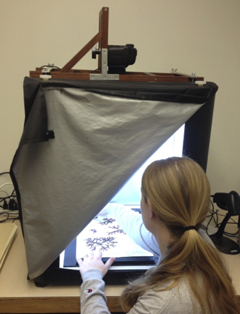The FHL Algal Herbarium moves into the 21st Century
Tom Mumford
 Figure 1. The FHL Synoptic Collection of Marine Algae. Nearly 4,000 specimens of marine algae are preserved in a total of four cabinets. These have been collected since the early 1900s. Because they are air dried and not preserved in formalin, DNA can be extracted from fragments and used for modern molecular systematics and taxonomy research. Photo credit: Tom Mumford.
Figure 1. The FHL Synoptic Collection of Marine Algae. Nearly 4,000 specimens of marine algae are preserved in a total of four cabinets. These have been collected since the early 1900s. Because they are air dried and not preserved in formalin, DNA can be extracted from fragments and used for modern molecular systematics and taxonomy research. Photo credit: Tom Mumford.
The synoptic collection for marine algae, or the algal herbarium, at the Friday Harbor Labs is an important tool for the study of the local marine flora (Fig. 1). Specimens have been collected, floated out on paper, pressed and dried, then stored in folders placed in cabinets since the earliest days of the Puget Sound Biological Station. These specimens have been used for teaching and research. Most of the preeminent phycologists of the last century have done research at FHL and all placed specimens in the herbarium that they used in theory research or descriptions of new species. Recently many type specimens — the original plant from which a new species is described — were moved to the Burke Museum, but thousands of sheets remain at FHL. This collection represents a record over time of the incredible biodiversity of the algal flora in the San Juan Archipelago and Washington State. Because most of these specimens were gently air dried, they can now be used to extract DNA used in modern molecular systematics. This collection was cataloged and entered into a database by Victoria Wyllie-Echeverria and is available online at: http://tinyurl.com/FHLherbarium
As with all herbaria, access to this collection has been problematic. In the past, in order to study the specimens a researcher had to come to the Labs or arrange for herbarium sheets to be sent to them. The sheets are fragile, and repeated handling in some cases has been detrimental. The digital catalogue, while useful, is not widely known and is not part of the increasingly digitized world of herbarium collections.
This has all recently changed.
 Figure 2. Burke Museum staff member Sara Legler prepares an herbarium sheet for processing. Each herbarium sheet now has a bar code sticker affixed with a unique identifier to lessen errors when dealing with large number of specimens. Photo credit: Kathleen Ballard.
Figure 2. Burke Museum staff member Sara Legler prepares an herbarium sheet for processing. Each herbarium sheet now has a bar code sticker affixed with a unique identifier to lessen errors when dealing with large number of specimens. Photo credit: Kathleen Ballard.
The University of Washington Herbarium (also known as WTU) is housed at UW's Burke Museum, which received a grant from the National Science Foundation (NSF) in August of 2013. The grant funding is allowing the museum to image its 16,000+ algal specimens and place those images and all the collection (label) information in a database. The grant has been expanded to include the specimens in FHL's herbarium as well. Two Burke staffers came to the Labs in April 2014 and captured 4,116 images of 3,919 specimens during their one-week stay. Bar code labels were placed on each sheet and the data from the labels will be added to the WTU database (Fig. 2).
This grant is a part of a larger collaborative NSF grant involving multiple universities and herbaria around the country. The goals of this collaborative grant are to image and database as many of the macroalgae specimens in U.S. herbaria as possible, and make this combined dataset available online for use by researchers and the public (Fig. 3). A nascent portal to the data is available here: http://tinyurl.com/macroalgae
Information about the grant is available at http://tinyurl.com/WTUgrant and at iDigBio.
 Figure 3. Preparing an herbarium sheet for photo digitization. The light tent provides even, shadow-free illumination. The overhead digital camera feeds directly into a laptop computer. The image of each sheet is used to copy all label information into the database. Photo credit: Tom Mumford.
Figure 3. Preparing an herbarium sheet for photo digitization. The light tent provides even, shadow-free illumination. The overhead digital camera feeds directly into a laptop computer. The image of each sheet is used to copy all label information into the database. Photo credit: Tom Mumford.
Imaging was just the first step. The Burke staff filled out database records for each of the imaged specimens. By the time you read this, images and data will be available through the PNW Herbaria website. Data will then be transferred to the MacroAlgae portal listed above and iDigBio. Some of the algae specimens are being geo-referenced, allowing specimens to be mapped and used in geospatial analyses (for examples, see the PNW Herbaria site or B.C. E-Flora).
The downside is that there are no definite plans to keep up with any newly added accessions at FHL. It will be up to FHL to arrange to have Burke staff periodically come and update the database, have FHL staff do the work, or use researchers, students, or volunteers to do so.
As of now, the untold hours of effort since 1904 in collecting and preserving these thousands of specimens are able to be easily shared with the world-wide scientific community. A mostly-hidden resource of the Friday Harbor Labs has become “on-line!” Now the herbarium can be more easily used to detect changes in biodiversity from global climate change, water quality degradation, or development.
Acknowledgements: My thanks to Ben Legler at the Burke Museum for providing information on the NSF grant and websites.



